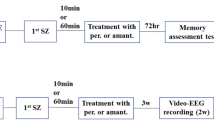Abstract
Purpose. We evaluated the effectiveness of the commonly used antiepileptic drug sodium valproate (400 mg/kg) and two of its amide derivatives, valpromide and valnoctamide (both 100 mg/kg), in an in vivo rat model of focal epilepsy. Our main interest was to get insight into possible changes in extracellular amino acid neurotransmitter levels following administration of the drugs, both in control and in epileptic conditions.
Methods. Seizures were evoked in freely moving rats by intrahippocampal administration of pilocarpine via a microdialysis probe (10 mM for 40 min at 2 μl/min). Microdialysis was also used as in vivo sampling technique and alterations in extracellular hippocampal glutamate and GABA levels were monitored. Electrophysiological evidence for the presence or absence of seizures was simultaneously recorded with electrocorticography.
Results. The focally evoked pilocarpine-induced seizures were completely prevented by acute intraperitoneal pretreatment with each of the three drugs in the respective doses. Effective protection was reflected in the electrocorticographic recordings and in the lack of sustained elevations of the extracellular glutamate levels after pilocarpine perfusion. Little effects were seen on the basal extracellular amino acid levels after systemic administration of each of the compounds, nor after the intrahippocampal administration of sodium valproate.
Conclusions. Valnoctamide and valpromide (100 mg/kg) proved to be at least as effective as their parent compound sodium valproate (400 mg/kg) against pilocarpine-induced seizures. All three compounds however failed to induce significant initial alterations in extracellular hippocampal GABA release. This questions the enhancement of GABA-mediated inhibition as being one of their mechanisms of action.
Similar content being viewed by others
REFERENCES
M. Bialer, A. Haj-Yehia, K. Badir, and S. Hadad. Review: Can we develop improved derivatives of valproic acid? Pharmacy World & Science 16:2-6 (1994).
M. A. Rogawski and R. J. Porter. Antiepileptic drugs: Pharmacological mechanisms and clinical efficacy with consideration of promising developmental stage compounds. Pharmacol. Rev. 42: 223-286 (1990).
R. L. Macdonald and K. M. Kelly. Antiepileptic drug mechanisms of action. Epilepsia 34(Suppl. 5):S1-S8 (1993).
W. Löscher. Valproate: A reappraisal of its pharmacodynamic properties and mechanisms of action. Prog. Neurobiol. 58:31-59 (1999).
M. Radatz, K. Ehlers, B. Yagen, M. Bialer, and H. Nau. Valnoctamide, valpromide and valnoctic acid are much less teratogenic in mice than valproic acid. Epilepsy Res. 30:41-48 (1998).
W. Löscher and H. Nau. Pharmacological evaluation of various metabolites and analogues of valproic acid. Anticonvulsant and toxic potencies in mice. Neuropharmacology 24:427-435 (1985).
S. Blotnik, F. Bergman, and M. Bialer. Disposition of valpromide, valproic acid, and valnoctamide in the brain, liver, plasma, and urine of rats. Drug Metab. Disp. 24:560-564 (1996).
W. A. Turski, E. A. Cavalheiro, C. Coimbra, M. Berzaghi, C. Ikonomidou-Turski, and L. Turski. Only certain antiepileptic drugs prevent seizures induced by pilocarpine. Brain Res. Rev. 12:281-305 (1987).
I. Smolders, G. M. Khan, J. Manil, G. Ebinger, and Y. Michotte. NMDA receptor-mediated pilocarpine-induced seizures: characterization in freely moving rats by microdialysis. Br. J. Pharmacol. 121:1171-1179 (1997).
J. P. Leite and E. A. Cavalheiro. Effects of conventional antiepileptic drugs in a model of spontaneous recurrent seizures in rats. Epilepsy Res. 20:93-104 (1995).
G. Paxinos and C. Watson. The Rat Brain in Stereotaxic Coordinates, 2nd edition, Academic Press Inc., San Diego, 1986.
I. Smolders, S. Sarre, Y. Michotte, and G. Ebinger. The analysis of excitatory, inhibitory and other amino acids in rat brain microdialysates using microbore liquid chromatography. J. Neurosci. Meth. 57:47-53 (1995).
M. Isokawa and L. E. Mello. NMDA receptor-mediated excitability in dendritically deformed dentate granule cells in pilocarpine-treated rats. Neurosci. Lett. 129:69-73 (1991).
L. E. Mello, E. A. Cavalheiro, A. M. Tan, W. R. Kupfer, J. K. Pretorius, T. L. Babb and D. Finch. Circuit mechanisms of seizures in the pilocarpine model of chronic epilepsy: Cell loss and mossy fiber sprouting. Epilepsia 34:985-995 (1993).
M. Marchi, P. Bocchieri, L. Garbarino, and M. Raiteri. Muscarinic inhibition of endogenous glutamate release from rat hippocampus synaptosomes. Neurosci. Lett. 96:229-234 (1989).
R. J. Valentino and R. Dingledine. Presynaptic inhibitory effect of acetylcholine in the hippocampus. J. Neurosci. 1:784-792 (1981).
I. Smolders, K. Van Belle, G. Ebinger, and Y. Michotte. Hippocampal and cerebellar extracellular amino acids during pilocarpine-induced seizures in freely moving rats. Eur. J. Pharmacol. 319:21-29 (1997).
I. Smolders, G. M. Khan, H. Lindekens, S. Prikken, C. A. Marvin, J. Manil, G. Ebinger, and Y. Michotte. Effectiveness of vigabatrin against focally evoked pilocarpine-induced seizures and concomitant changes in extracellular hippocampal and cerebellar glutamate, GABA and dopamine levels, a microdialysis-electrocorticography study in freely moving rats. J. Pharmacol. Exp. Ther. 283:1239-1248 (1997).
C. S. Biggs, B. R. Pearce, L. J. Fowler, and P. S. Whitton. The effect of sodium valproate on extracellular GABA and other amino acids in the rat ventral hippocampus: An in vivo microdialysis study. Brain Res. 594:138-142 (1992).
V. Armand, J. Louvel, R. Pumain, and U. Heinemann. Effects of new valproate derivatives on epileptiform discharges induced by pentylenetetrazole or low Mg2+ in rat entorhinal cortex-hippocampus slices. Epilepsy Res. 32:345-355 (1998).
Author information
Authors and Affiliations
Rights and permissions
About this article
Cite this article
Lindekens, H., Smolders, I., Khan, G.M. et al. In Vivo Study of the Effect of Valpromide and Valnoctamide in the Pilocarpine Rat Model of Focal Epilepsy. Pharm Res 17, 1408–1413 (2000). https://doi.org/10.1023/A:1007559208599
Issue Date:
DOI: https://doi.org/10.1023/A:1007559208599



